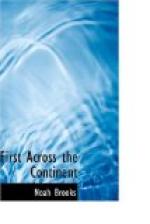Next day, the hunter killed the largest elk which they had ever seen. It stood five feet three inches high from hoof to shoulder. Antelopes were also numerous, but lean, and not very good for food. Of the antelope the journal says:—
“These fleet and quick-sighted animals are generally the victims of their curiosity. When they first see the hunters, they run with great velocity; if he lies down on the ground, and lifts up his arm, his hat, or his foot, they return with a light trot to look at the object, and sometimes go and return two or three times, till they approach within reach of the rifle. So, too, they sometimes leave their flock to go and look at the wolves, which crouch down, and, if the antelope is frightened at first, repeat the same manoevre, and sometimes relieve each other, till they decoy it from the party, when they seize it. But, generally, the wolves take them as they are crossing the rivers; for, although swift on foot, they are not good swimmers.”
Later wayfarers across the plains were wont to beguile the antelope by fastening a bright-colored handkerchief to a ramrod stuck in the ground. The patient hunter was certain to be rewarded by the antelope coming within range of his rifle; for, unless scared off by some interference, the herd, after galloping around and around and much zigzagging, would certainly seek to gratify their curiosity by gradually circling nearer and nearer the strange object until a deadly shot or two sent havoc into their ranks.




